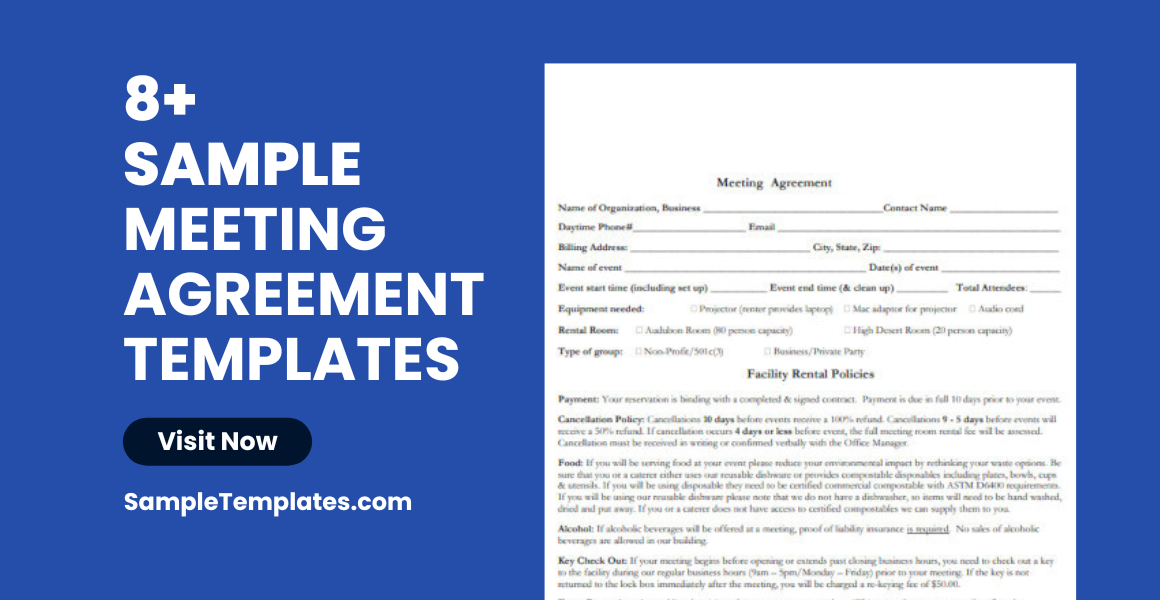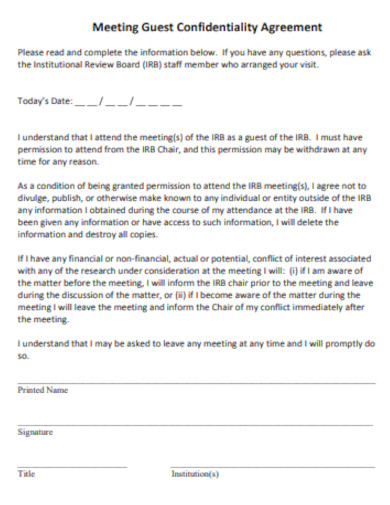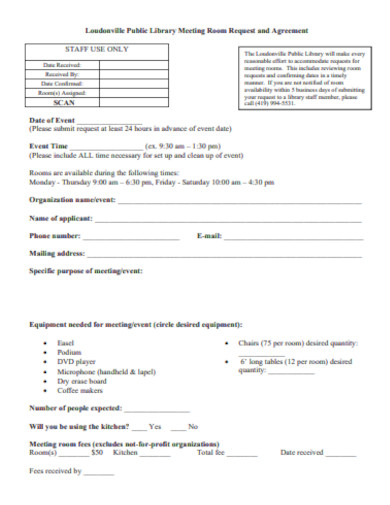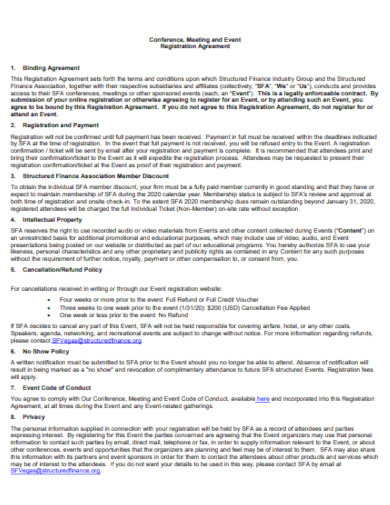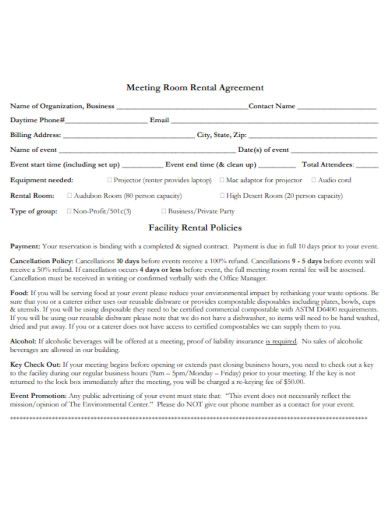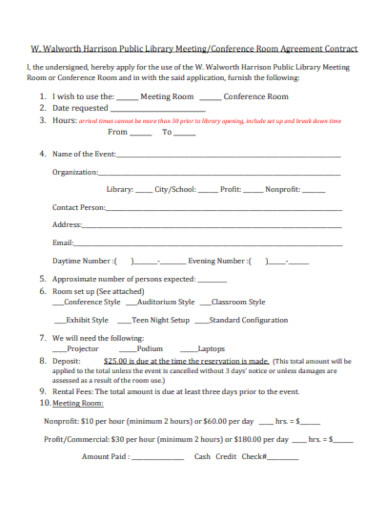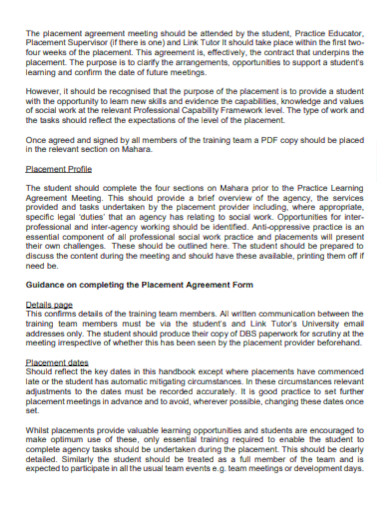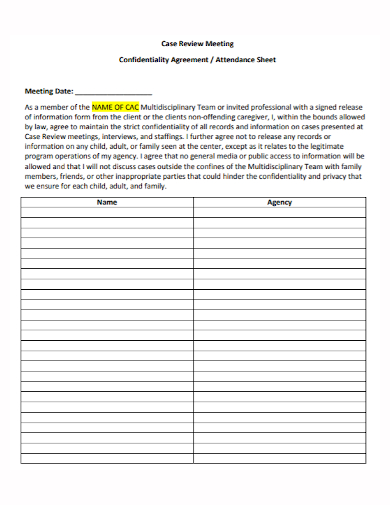FREE 8+ Meeting Agreement Samples
1. Sample Meeting Confidentiality Agreement Template
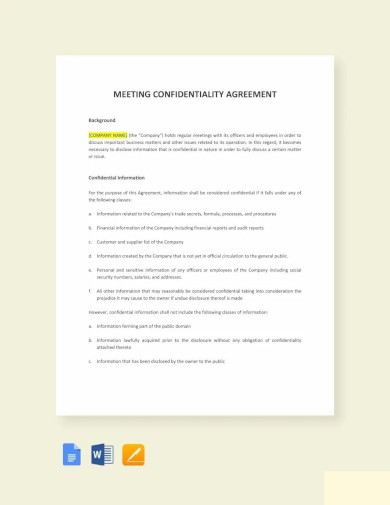
2. Sample Meeting Guest Confidentiality Agreement Template
3. Sample Meeting Room Request Agreement Template
4. Sample Meeting Registration Agreement Template
What is a Meeting Agreement?
In the realm of business and organizational management, a meeting sample agreement stands as a pivotal tool that ensures discussions are productive, time-efficient, and conducive to a collaborative environment. It is a collectively constructed document or set of guidelines agreed upon by all participants before a meeting commences. This agreement sample outlines the expected behaviors, norms, and rules that will govern the meeting process.
Purpose and Importance of a Meeting Agreement
The primary purpose of a meeting agreement is to create a clear framework within which all participants can operate. It sets the tone for the meeting and provides a reference point for acceptable behavior and procedures. This is crucial in avoiding misunderstandings and conflicts, ensuring that the meeting’s objectives are met effectively.
Key Elements of a Meeting Agreement
A comprehensive meeting agreement typically includes the following elements:
- Objectives: Clearly defined goals for what the meeting aims to achieve.
- Agenda: A structured outline of topics to be discussed, often with allocated time slots.
- Roles and Responsibilities: Designation of roles such as the facilitator, note-taker, and timekeeper.
- Participation Guidelines: Expectations for how participants should engage, including speaking turns, listening respectfully, and contributing constructively.
- Decision-Making Process: The method by which decisions will be made, whether by consensus, majority vote, or executive decision.
- Confidentiality and Privacy: Agreements on how information shared during the meeting will be treated post-discussion.
- Follow-Up Procedures: Steps to be taken after the meeting, including the distribution of minutes and the execution of action items.
Examples of Meeting Agreements
Here are a few examples of common clauses found in meeting agreements:
- “Participants agree to start and end the meeting on time.”
- “All members will actively participate by providing ideas and feedback.”
- “We will respect each other’s viewpoints and speak one at a time.”
- “Decisions will be made through a consensus-building process.”
- “Confidential matters discussed will not be shared outside of this meeting without group consent.”
Benefits of Implementing a Meeting Agreement
Implementing a meeting agreement can lead to numerous benefits, including:
- Enhanced Focus: With a clear sample agenda and objectives, participants are more likely to stay on topic.
- Increased Efficiency: Time is used wisely, and meetings are more likely to end on time.
- Improved Participation: Clear guidelines encourage equal participation and discourage dominance by any single attendee.
- Better Outcomes: A structured decision-making process helps in achieving the desired outcomes of the meeting.
A Meeting Agreement should typically include the following information
1. Title: Clearly state that the document is a Meeting Agreement.
2. Purpose: Outline the sample objectives of the agreement and the specific goals for meetings.
3. Scope: Define the scope of meetings the agreement applies to (e.g., team meetings, board meetings).
4. Participants: List the roles or names of individuals who are part of the meeting group.
5. Date and Duration: Specify the effective date and the duration for which the agreement is valid.
6. Guidelines for Conduct:
- Punctuality: Expectations for starting and ending times.
- Participation: Encouragement of active and equitable participation.
- Communication: Rules for respectful and constructive communication.
- Decision-Making: Procedures for making decisions (consensus, majority vote, etc.).
- Confidentiality: Agreement on what information, if any, should remain confidential.
- Conflict Resolution: Steps for addressing and resolving disagreements.
7. Roles and Responsibilities:
- Facilitator: Who will lead or facilitate the meeting.
- Note-Taker: Person responsible for taking and distributing minutes.
- Timekeeper: Individual tasked with keeping the meeting on schedule.
8. Agenda:
Agreement on how the agenda is set, who sets it, and how it is shared before the meeting.
9. Follow-Up Actions:
- Action Items: How action items are recorded and assigned.
- Accountability: Mechanisms for ensuring follow-through on commitments.
10. Review Process:
- Feedback: How participants can provide a sample feedback on meetings.
- Adjustments: How and when the agreement will be reviewed and updated.
11. Signatures or Acknowledgment:
A section for participants to sign or otherwise acknowledge their agreement to the terms.
12. Distribution:
Information on how the agreement format will be distributed and where it will be accessible for future reference.
5. Sample Meeting Room Rental Agreement Template
6. Sample Meeting Agreement Contract Template
7. Sample Placement Agreement Meeting Template
8. Sample Case Review Meeting Confidentiality Agreement
9. Sample Committee Meeting Agreement Template
How do you Create a Meeting Agreement?
Creating a Meeting Agreement:
- Convene a Pre-Meeting: Gather all potential meeting participants to discuss the need for a meeting agreement.
- Establish Objectives: Clearly define what you want to achieve with the meeting agreement. This could be to improve efficiency, enhance communication, or ensure respectful dialogue.
- Brainstorm Key Elements: Encourage participants to suggest what they believe should be included in the agreement. This might cover punctuality, participation, decision-making, confidentiality, and conflict resolution.
- Draft the Agreement: Based on the brainstorming session, draft an agreement that outlines the expectations and rules for meeting conduct.
- Review and Revise: Share the draft with the group and allow time for review and feedback. Make revisions as necessary to ensure the agreement meets the needs of all participants.
- Finalize the Agreement: Once consensus is reached, finalize the document. Make sure it is clear, concise, and easy to understand.
- Gain Commitment: Have all meeting participants acknowledge the agreement. This could be through a signature or a verbal commitment in the presence of the group.
- Display and Enforce: Make the agreement visible during meetings and refer to it at the start of each meeting as a reminder. Enforce the rules as agreed upon.
- Evaluate and Adapt: Periodically review the effectiveness of the meeting agreement and make adjustments as the needs of the group evolve. You can also see more templates like
When should a meeting agreement be used?
A meeting agreement should be used during all meetings where it is applicable. It’s especially useful for recurring meetings, team collaborations, and discussions that require a high level of cooperation.
How do we ensure everyone follows the meeting agreement?
The agreement should be visibly displayed during the meeting and reviewed at the start of each session. It’s also important to regularly remind participants of the agreement and address any breaches immediately and constructively.
How long should a meeting agreement be?
A meeting agreement should be as long as necessary to cover all essential guidelines but as short as possible to ensure it is easy to understand and follow.
In conclusion, a meeting agreement is not just a document; it’s a commitment to collaborative efficiency and respect. By establishing and adhering to a well-crafted meeting agreement, teams can foster an environment where ideas flourish, decisions are made judiciously, and meeting time is optimized for the benefit of all involved. You can also see more templates like Sample Room Rental Agreements.
Related Posts
FREE 10+ Mentoring Agreement Samples In MS Word | Apple Pages | PDF
FREE 10+ Partner Agreement Samples In MS Word | Google Docs | Apple Pages | PDF
FREE 10+ Individual Agreement Samples In MS Word | Google Docs | Apple Pages | PDF
FREE 10+ Strategic Agreement Samples In MS Word | Google Docs | Apple Pages | PDF
FREE 10+ Equity Agreement Samples In MS Word | Google Docs | Apple Pages | PDF
FREE 10+ Producer Agreement Samples in MS Word | Apple Pages | PDF
FREE 10+ Grant Agreement Samples In MS Word | Apple Pages | PDF
FREE 10+ Community Agreement Samples In MS Word | Google Docs | PDF
FREE 8+ Real Estate Option Agreement Samples in MS Word | PDF
FREE 10+ Call Option Agreement Samples In MS Word | PDF
FREE 10+ Advertising Agreement Samples In MS Word | Google Docs | Apple Pages | PDF
FREE 10+ Car Agreement Samples In MS Word | Google Docs | Apple Pages | PDF
FREE 10+ Horse Agreement Samples In MS Word | Apple Pages | PDF
FREE 10+ Option Agreement Samples In MS Word | Google Docs | Apple Pages | PDF
FREE 9+ Project Management Agreement Samples in DOC | PDF
